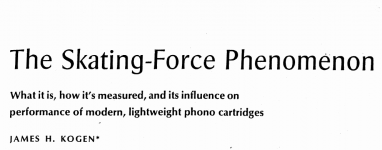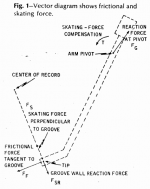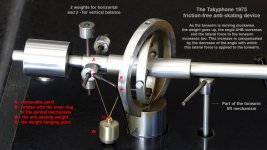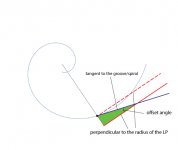The "anti-skating mechanism" does not compensate skating!
The anti skating mechanism does compensate skating. However, the skating force isn't constant, but anti skating mechanism can only apply a constant force.
Member
Joined 2019
The anti skating mechanism does compensate skating. However, the skating force isn't constant, but anti skating mechanism can only apply a constant force.
It depends on what you call "skating force". If you name so the "mother-force" directed towards the groove motion, the anti skating mechanism does not compensate this force, but it's lateral component.
If you name "skating force" the lateral component, the things are as you describe them. In the second case the authors call the mother force "frictional force". I agree to accept this terminology for the future.
It depends on what you call "skating force". If you name so the "mother-force" directed towards the groove motion, the anti skating mechanism does not compensate this force, but it's lateral component.
If you name "skating force" the lateral component, the things are as you describe them. In the second case the authors call the mother force "frictional force". I agree to accept this terminology for the future.
I don't see the difference here. A skating force is a combination force of a lot things. Anti skating device is to compensate the combined force towards to the center of the LP.
Member
Joined 2019
I don't see the difference here.
The difference is in terminology. If I call "skating force" the lateral component of the "friction force", then there is no problem. And I will do this in the future.
BTW, in my 1975 pivoted DIY turntable I included a friction-free anti-skating device. A weight was hanging between 2 points: one immovable and the other - rotating with the tonearm horizontal rotation cardan component. The rise of the lateral force during the movement of the tonearm towards the disk center was compensated (in high degree) with the change of the angle of the application of the weight force.
Last edited:
Hi. I feel here some misuse of definitions.
Hello Panayotis Kritidis,
So do I. There is no such thing as a "skating force". There is only an "inside force" As long as this inside force is reasonably compensated, there is no skating. Skating is the result of the uncompensated inside force. Skating occurs, when the stylus jumps one or more grooves.
The stylus holder may be always parallel to the groove direction
The stylus holder (cantilever) should never be parallel (or tangential) to what you call the groove direction, instead it should be perpendicular to the radius of the LP. The groove is a spiral and it intersects the radius of the LP at an angle which in turn depends upon the groove pitch.
Sincerely,
Ralf
super10018
This post is one big ERROR from beginning to end. I saw my life flashing by before my eyes in an attempt to answer it.
Ralf
Ralf
I understand what you are saying perfectly. If you want to dig deep, you didn’t go far enough. In fact, the groove is not a simple curve, it is a complicated waveform. Therefore, saying the cantilever is perpendicular to the radius of the LP doesn’t mean anything either because skating force still exists caused by the waveforms and the spiral. So is your arm and so are all the linear tracking arms and pivot arms.
If my assumption is not reasonable for analysis of skating, the assumption for the classic calculations of Loefgren and Baerwald is not reasonable either. The two null points are not null points anymore because there are tracking error at these two null points. Since everyone accept Loefgren and Baerwald’s assumption, I don’t see why my assumption is not acceptable.
Jim
This post is one big ERROR from beginning to end. I saw my life flashing by before my eyes in an attempt to answer it.
Ralf
Member
Joined 2019
So do I. There is no such thing as a "skating force". There is only an "inside force" As long as this inside force is reasonably compensated, there is no skating. Skating is the result of the uncompensated inside force. Skating occurs, when the stylus jumps one or more grooves.
Again .. this is a matter of definitions and namings. In his classic work on the skating issue, James Kogen uses the term "skating force" already in the title. (Att.1). He calls the "mother force" "frictional force" (Att.2) . I agree to use this terminology. You call "skating" the result of uncompensated 'inside force', or the result of uncompensated 'skating force' according to Kogen's terminology.
But, as a physicist I have to go further. The compensation of the skating force does not mean that it dissapears. It is only compensated (in certain degree). So we have the skating force alive, the antiskating force alive and opposite in direction and the result of their co-existence - a significantly lower lateral force.
The stylus holder (cantilever) should never be parallel (or tangential) to what you call the groove direction, instead it should be perpendicular to the radius of the LP. The groove is a spiral and it intersects the radius of the LP at an angle which in turn depends upon the groove pitch.
The two things coincide. You are wrong when you say that the tangent of a spiral in some point is not perpendicular to the spiral radius in that point. The cutting stylus during the master LP creation is moving always in the direction of the current groove radius (talking about the horizontal component of the moves) and tangentially to the direction of the groove's rotational movement.
Attachments
Member
Joined 2019
As your diagram shows correctly, the force perpendicular to the groove is called skating force, contrary to your earlier statement that the frictional force is the skating force.
Yes, I wrote already that I will conform with the Kogan's terminology. But I wrote also that some misunderstandings are caused by different uses of the terms. E.g. the statement 'There is no such thing as a "skating force" ' of Straight Tracker.
This post is one big ERROR from beginning to end. I saw my life flashing by before my eyes in an attempt to answer it.
Ralf
OK. LET IT BE.
An easy way to visualize what’s parallel, tangent, or perpendicular is to consider motion in the runout groove. The cutterhead stylus holder (cantilever) is/was always perpendicular to the radius of the LP, including through the runout groove. A line drawn tangent to the groove/spiral, and through the point of intersection of the radius of the LP and the playback stylus, will not be perpendicular to the radius of the LP. Even so, if there were audio information recorded in the runout groove/spiral, it would still be played back correctly provided the playback stylus (cantilever) is held perpendicular to the radius of the LP by the tonearm.
To lighten things up a little bit, here's a fun interactive graphic to play with:
Tangent on a Logarithmic Spiral - Wolfram Demonstrations Project
Ray K
To lighten things up a little bit, here's a fun interactive graphic to play with:
Tangent on a Logarithmic Spiral - Wolfram Demonstrations Project
Ray K
Member
Joined 2019
In the photo from the Kogan's original work, which I posted in #2007, the author uses the expressions "Frictional force tangent to groove" and "Skating force perpendicular to groove". He does not mention the slight deviation of the linear spiral from the tangentiality. Because it is quite small.
The modulated grooves of the disk form a 'quasi-linear' spiral with a step varying typically within 0.06 - 0.20 mm. (Oh, yes, we have to analyze the role of this variation too..). Taking the case of a constant step of 0.1 mm, we have the spiral formula in polar coordinates
R = A + Bθ , where
A is the radius of the innermost modulated groove
θ is the angle of rotation, let's measure it in radians, and
B = 0.1/(2π) = 0.0159 mm/rad
Can somebody write the value of the angular deviation of the spiral groove from tangentiality to the radius for these spiral values? I am trying to calculate it and got a value nearly 0.05 degrees.
The modulated grooves of the disk form a 'quasi-linear' spiral with a step varying typically within 0.06 - 0.20 mm. (Oh, yes, we have to analyze the role of this variation too..). Taking the case of a constant step of 0.1 mm, we have the spiral formula in polar coordinates
R = A + Bθ , where
A is the radius of the innermost modulated groove
θ is the angle of rotation, let's measure it in radians, and
B = 0.1/(2π) = 0.0159 mm/rad
Can somebody write the value of the angular deviation of the spiral groove from tangentiality to the radius for these spiral values? I am trying to calculate it and got a value nearly 0.05 degrees.
Can somebody write the value of the angular deviation of the spiral groove from tangentiality to the radius for these spiral values? I am trying to calculate it and got a value nearly 0.05 degrees.
I think there is a nuclear physicist on the forum. Perhaps he will provide the answer for us.
Ray K
Member
Joined 2019
I think there is a nuclear physicist on the forum. Perhaps he will provide the answer for us.
Ray K
Oh, how I like qualitative statements..!
- There is some effect A
- What is the quantitative estimate for A ?
- (Polite silence)
I asked a friend of mine, professor of mathematics, what is the angle of a linear spiral curve with respect to the radius line - that to the center of the spiral. He could not point to me some expression, but he was sure that the angle is not exactly 90o. "If it was 90o, we would have a circle, not a spiral", he said in his typical convincing manner.
I will gladly join what was named "we" and will wait with all that "we" an answer from the nuclear physicist. In some other post I will discuss the basic totalitarian propaganda tricks, one of which is to name some undefined group "we", in order to confront the enemy of the people "he" (or "she").
Last edited:
For the benefit of those who might not have this information, Kogen’s article appeared as a two-part series in Audio Magazine in 1967:
James Kogen, October 1967 Audio Magazine Part 1 [for Shure Brothers]
https://www.americanradiohistory.com/Archive-Audio/60s/Audio-1967-10.pdf
James Kogen, November 1967 Audio Magazine Part 2 [for Shure Brothers]
https://www.americanradiohistory.com/Archive-Audio/60s/Audio-1967-11.pdf
However, Kogen’s work is pre-dated by George Alexandrovich who filed a patent application for an anti-skating device in October 1960 and was granted the patent in May 1963.
George Alexandrovich, US Patent 3,088,742 [for Fairchild Corporation]
US3088742A - Compensated tone arms
- Google Patents
Regardless what we argue about calling the 'skating' phenomenon now, the patent officially reads “COMPENSATED TONE ARMS”.
The Alexandrovich patent cites an even earlier patent 1,866,403 which was issued in 1932 to Bell Labs for “counter-balancing the lateral component of the force of friction between the stylus and the record”.
US1866403A - Phonograph recorder and reproducer arm
- Google Patents
The documentation of these side forces pre-dates all of us, yet here we are still arguing over it.
Ray K
James Kogen, October 1967 Audio Magazine Part 1 [for Shure Brothers]
https://www.americanradiohistory.com/Archive-Audio/60s/Audio-1967-10.pdf
James Kogen, November 1967 Audio Magazine Part 2 [for Shure Brothers]
https://www.americanradiohistory.com/Archive-Audio/60s/Audio-1967-11.pdf
However, Kogen’s work is pre-dated by George Alexandrovich who filed a patent application for an anti-skating device in October 1960 and was granted the patent in May 1963.
George Alexandrovich, US Patent 3,088,742 [for Fairchild Corporation]
US3088742A - Compensated tone arms
- Google Patents
Regardless what we argue about calling the 'skating' phenomenon now, the patent officially reads “COMPENSATED TONE ARMS”.
The Alexandrovich patent cites an even earlier patent 1,866,403 which was issued in 1932 to Bell Labs for “counter-balancing the lateral component of the force of friction between the stylus and the record”.
US1866403A - Phonograph recorder and reproducer arm
- Google Patents
The documentation of these side forces pre-dates all of us, yet here we are still arguing over it.
Ray K
Member
Joined 2019
The documentation of these side forces pre-dates all of us, yet here we are still arguing over it.
Ray K
Very nice materials! I did not know that of 1932. As for the pre-dating, I was a second year student in 1963, so the publications of Alexandrovich and Kogen did not pre-date me. Of course, I did not learn about skating force that time. I think I learned it in the very late 60ies by seeing and listening to a new turntable that my friend had purchased. A Dual one.
Last edited:
Member
Joined 2019
Ralf and Ray,
I have still been thinking about your views. On second thought, I think I may be still right about the cantilever tangent to the groove of LP.
I used the model posted by Ray. Please see the diagram.
In the diagram, I added two lines red and blue. Both lines represent two arms.
For the red line(red arm), it is perpendicular to the radius of the LP. It does have tracking error and skating as well unless you add an offset angle. Adding an offset angle can only correct tracking error, but it can't eliminate skating.
For the blue line(blue arm), it is tangent to the groove(spiral). It doesn't have a tracking error and skating either. But it is not perpendicular to the radius of the LP.
The statement I made in my early post.
If an arm doesn't have skating, it must meet two conditions, i.e. the cantilever is tangent to groove and is overlapping the centerline of the arm wand. This is the blue line(blue arm) in the diagram.
It seems that my early statement is still correct.
Jim
I have still been thinking about your views. On second thought, I think I may be still right about the cantilever tangent to the groove of LP.
I used the model posted by Ray. Please see the diagram.
In the diagram, I added two lines red and blue. Both lines represent two arms.
For the red line(red arm), it is perpendicular to the radius of the LP. It does have tracking error and skating as well unless you add an offset angle. Adding an offset angle can only correct tracking error, but it can't eliminate skating.
For the blue line(blue arm), it is tangent to the groove(spiral). It doesn't have a tracking error and skating either. But it is not perpendicular to the radius of the LP.
The statement I made in my early post.
If an arm doesn't have skating, it must meet two conditions, i.e. the cantilever is tangent to groove and is overlapping the centerline of the arm wand. This is the blue line(blue arm) in the diagram.
It seems that my early statement is still correct.
Jim
Attachments
Last edited:
For the red line(red arm), it is perpendicular to the radius of the LP. It does have tracking error and skating as well unless you add an offset angle. Adding an offset angle can only correct tracking error, but it can't eliminate skating.
I should make a correction to my own post. In fact, saying perpendicular to the radius of the LP is the same as what I said tangent to the groove(spiral).
- Home
- Source & Line
- Analogue Source
- Angling for 90° - tangential pivot tonearms



